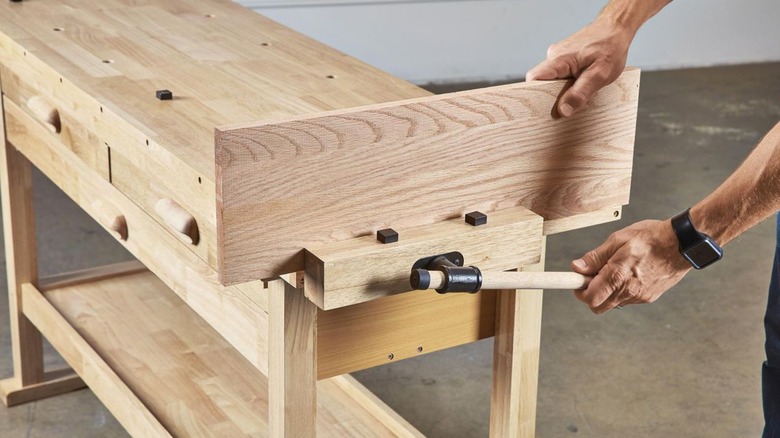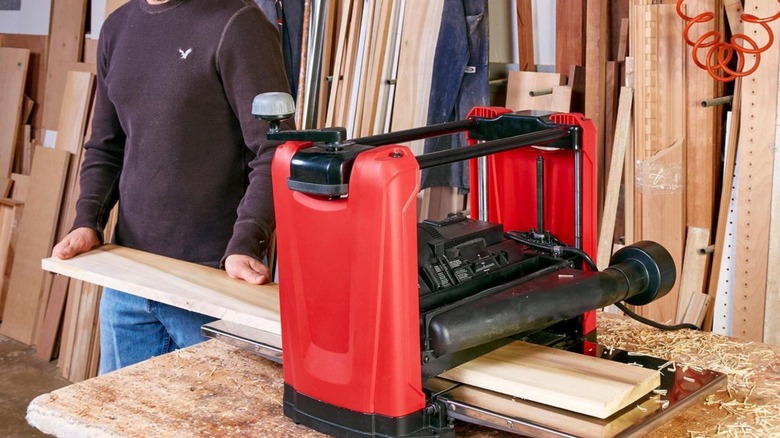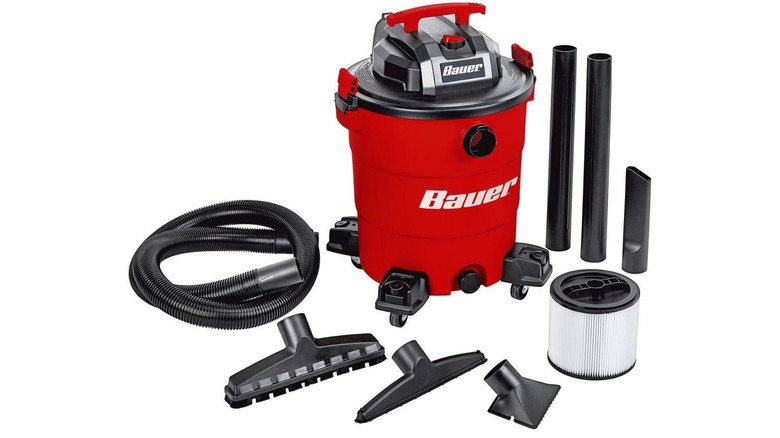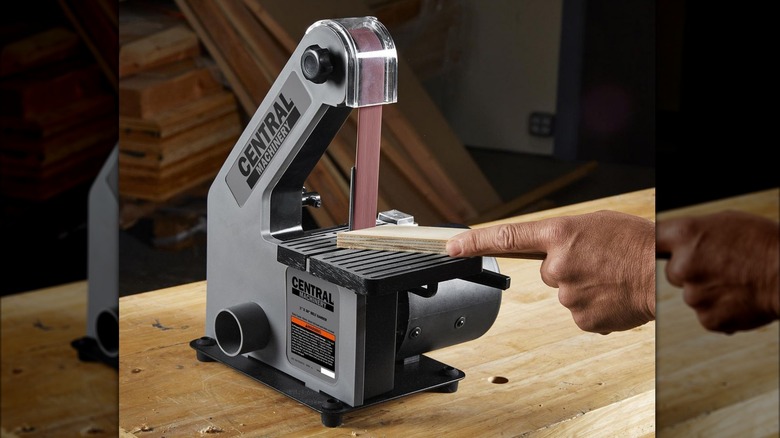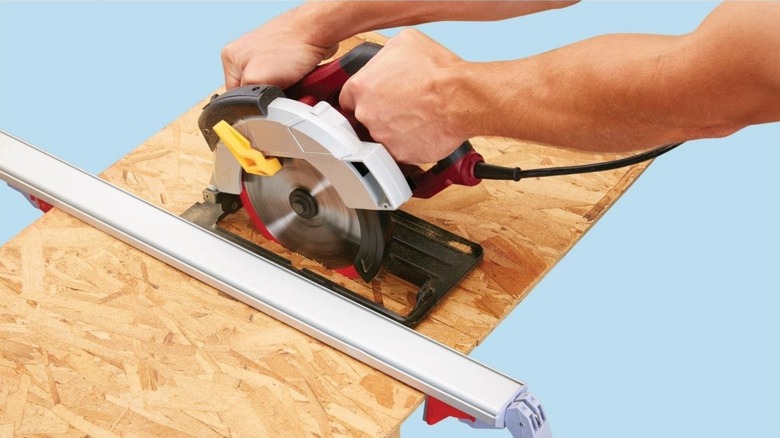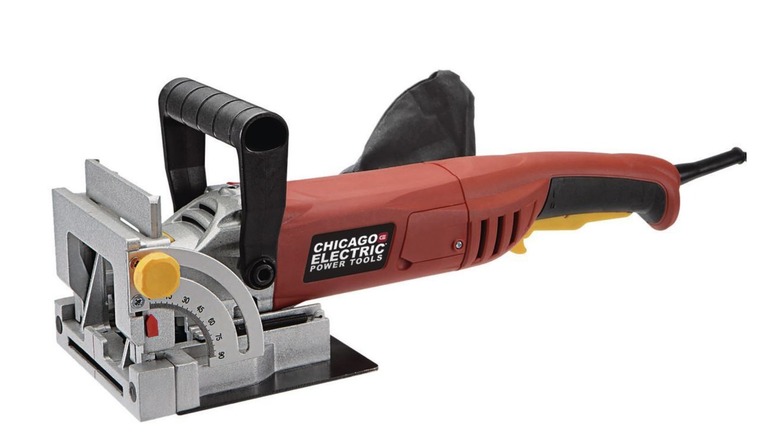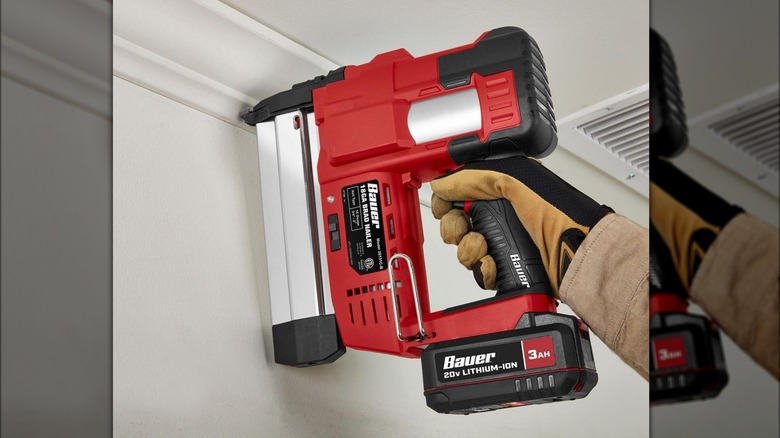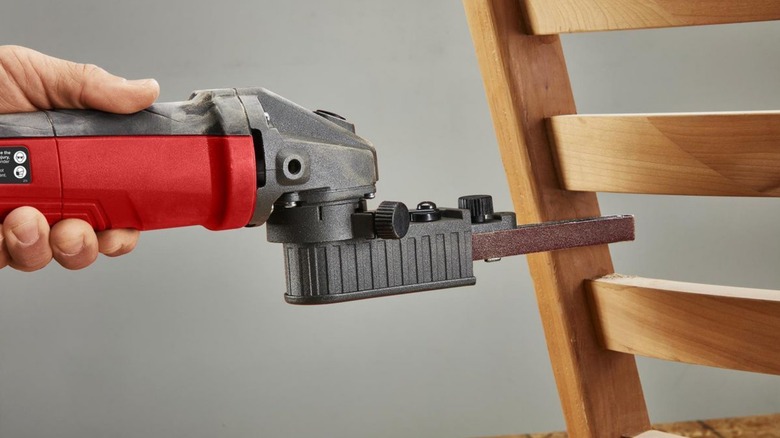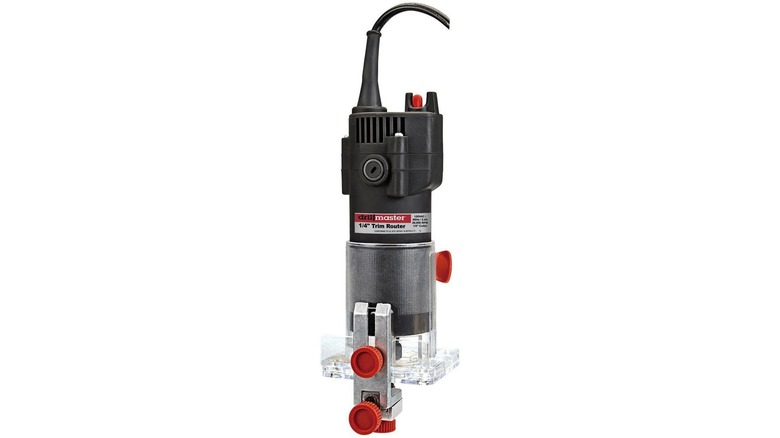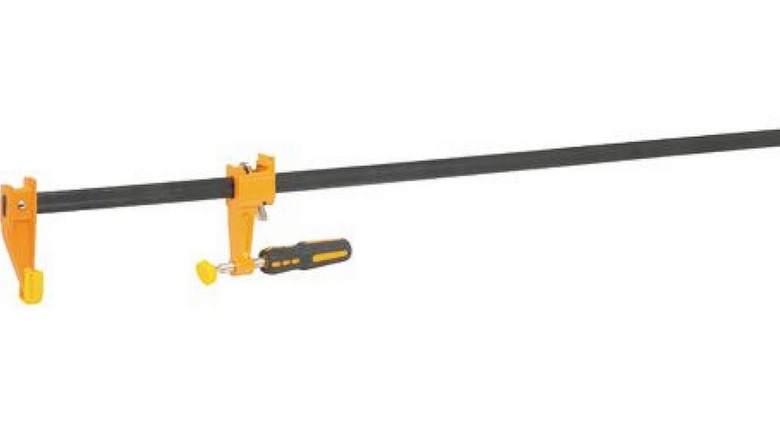10 Harbor Freight Tools Every At-Home Woodworker Will Want
Woodworking is a notoriously expensive hobby. In addition to the ever-higher price of lumber itself, the cost of tools and shop equipment can really add up. While some purists insist on only buying premium tools at woodworking shops, this can come at a pretty hefty price. Whether you're new to the craft and not willing to sink a lot of money into fitting out a shop right away or just on a budget, there are often cheaper options that can lower the cost of woodworking quite considerably.
For anybody who works with tools, the name Harbor Freight stands for low prices. Their parking lot tent sales and magazine ads offer rock-bottom prices on a wide array of different tools. But what are you really getting for those low prices? While some turn up their noses at the bargain basement retailer, others of us know that there are a lot of great values to be found at Harbor Freight if you're willing to do a bit of testing and research. Sometimes, you can find a lot of value for not a lot of money.
To help you decide which buys are good, we've compiled the top 10 Harbor Freight tools every at-home woodworker will want. Some of these offer comparable performance to more expensive options found elsewhere. Others, while maybe not quite as good as the competition, are tools that you don't necessarily use very often and may not be worth a big investment.
Workbench
You don't need a lot to get started woodworking. One of the first things you need is a good solid workbench to build them on. A workbench is where you fit, assemble, and join the workpieces in any project, and this one fits the bill quite nicely. It's square, sturdy, and made out of composite hardwood that feels stable. A few solid drawers and a built-in woodworking vise and bench dogs add some premium features that you don't often find at an entry-level workbench, including those that cost a lot more.
As this YouTube video shows, it requires some assembly out of the box, but nothing that even a beginning woodworker can't handle. At $179.99 — and frequently on sale for less—this bench comes ready to assemble for less money than the required wood and hardware would cost you if you tried to build it yourself.
A lot of woodworkers enjoy building their own workbench, with features and customizations that make it feel personal. For those who choose not to go the route of building the ultimate woodworking bench or for those who haven't gotten around to it yet, this solid hardwood unit is a steal for the price, with clean lines and true surfaces. Even if you decide to build an upgrade later on, this ready-made workbench makes for a good place to build your next one, and having this bench as a secondary workstation will rarely go unappreciated in any workshop.
Benchtop planer
As any woodworker knows, even high-quality "finished" lumber rarely comes perfectly straight and flat from the yard. To correct this, every shop needs a planer to smooth down and even out the wood surface, giving you a good, flat place to start building. It's also instrumental in reducing thickness to achieve uniform boards of the desired depth. The Bauer 12-1/2 inch Portable Thickness Planer is something of a basic unit and not the most feature-rich planer on the market. And like most entry-level planers, you can encounter a bit of snipe when the wood isn't perfectly aligned.
Despite its shortcomings, this benchtop planer is an indispensable part of any wood shop that fits the bill and planes boards flat. This is especially true for those who don't have room in the budget for models costing at least three times as much as this one's $349.99 price tag. With Harbor Freight's frequent sales, coupons, and member discounts, it's often available for even less, making this a good buy for anyone in need of a basic planer.
It's a shame Harbor Freight doesn't sell a bench joiner to compliment this inexpensive route to squaring off perfectly flat boards. This can be fixed using a table saw or even a simple circular saw, provided that you have a good, flat surface like this planer can provide.
Shop vacuum
Is it the most exciting entry on this list? Not by a long shot. But short of an expensive dust collection system, every shop needs a good way to get rid of sawdust. Even in shops that have such a system installed, the usefulness of this vacuum is pretty hard to argue with. It's easy to roll around the shop and deals with picking up wet messes as easily as it does dry ones. A good shop vacuum like this one is also incredibly useful when finishing a workpiece, as nothing ruins a beautiful paint or varnish job like the faint trace of sawdust left behind on the workpiece. Running a powerful vacuum like this one over the piece before finishing, along with some tack cloth, makes sure this won't happen.
To make dust collection even more efficient, Harbor Freight sells this Cyclone Dust Separator Kit. This attachment turns a straightforward shop vacuum into a more efficient, sawdust-specific cleanup machine, depositing most of the dust into a standard 5-gallon bucket. Less dust reaches the filter within the vacuum, keeping it running stronger for a longer period and allowing you to remove the sawdust without having to open up the whole unit.
Though you could spend more money on a vacuum for your workshop, this one works as well as its competition. And for a necessity that isn't all that exciting, it's probably not something you'll want to shell out a ton of money for.
Benchtop belt sander
Few benchtop tools cost less than their portable equivalent, but at $49.99, this handy little 1-in belt sander is just that. And there's a lot of value packed into this tiny little unit. It fits handily on a shelf or under the workbench, making it easy to pull out when you need it and convenient to store away when you don't.
The light-duty sander does double duty in the woodworking shop. It's incredibly useful for sanding irregular workpieces and rounded details on complicated work or anything smaller than what you'd want to take a handheld belt sander to. This YouTube review shows how useful it can be for getting into tight spaces and shaping curves on a precise wooden sculpture.
On top of its uses for precise wood sanding, this sander is perhaps even more useful for shaping and sharpening metal. While we're not talking about metalworking tools in this article, woodworking requires maintaining a lot of chisels, gouges, plane irons, and carving knives. All of these hand tools (and a lot of power tools as well) require sharpening and correcting the occasional chip or deformation. This little sander is a great tool for this purpose, setting you up with a reasonably powerful sharpening station when you want it and tucking it out of the way when you don't. This knife-making YouTube channel even used one to make a knife out of a file. It is not the perfect tool for a metalworker, but it is just what a woodworker needs.
Edge and saw guide
Many of us learned the old trick of clamping a board to a workpiece to provide a consistent edge along which to run a saw or a router. While this is a good, quick woodworking hack in a pinch, it's not the most elegant solution for the purpose. Furthermore, the edge it provides is only as good as the one on the board, which may very likely have its imperfections.
This handy tool provides a big improvement over that improvised edge. While it doesn't provide quite the precision that a track saw can, it's more than adequate for applying a very true edge in a variety of situations where one is needed. Not only is it perfectly straight and consistent, but it has a built-in clamping mechanism that makes it a lot easier than having to break out the old c-clamps. The squaring effect of this clamping mechanism also provides an easy way to ensure that your edge is also close to perfectly square–though it's always best to check with a proper square as well.
Harbor Freight isn't the only retailer that offers an edge like this one, but at $17.99, it may very well be the cheapest. An edge, as long as it's true, is an edge, so a cheaper one is just as good as one that costs twice as much. This is a useful tool that gives you a solid edge on the workpiece without breaking the bank.
Biscuit joiner
Some tools see pretty constant use in the workshop. Table saws and miter saws, for example, see action in just about any woodworking project, as do drills, sanders, and routers. When buying these workhorses, there's a strong argument for buying the best you can afford, as high-quality tools last longer and yield a far better experience, as well as a better-finished product.
But then there are the "one-trick ponies," the single-use tools that do one specific job and pretty much nothing else. For tools like these, it makes sense to ask whether the best you can buy is necessary. The biscuit joiner is one such tool, which spends a lot more time on the shelf than it does being used. It serves one straightforward purpose: cutting slots in workpieces for joining with small wooden biscuits. While there are alternatives to this, including the more traditional dowels, jig-drilled pocket screws, or Festool's DOMINO system, biscuits do a good job of lining up and bonding boards into a single panel for table tops, as well as making miter joints more secure.
A single-use tool full of great uses, this one makes clean and neat biscuit cuts for smooth and simple joinery. If you use biscuits all the time in a variety of projects, you may want a better tool. For most of us, however, this one is a solid buy.
Cordless brad nailer
When starting in woodworking, almost everyone begins driving nails the same way that people have been doing it for thousands of years: by pounding them in with a hammer. Especially with finish and trim work, this has a lot of drawbacks. Hammering is loud; it's hard work, and a misplaced blow can damage a workpiece. It's not always easy to drive nails precisely, and to make sure the heads don't protrude from the wood's surface; you have to follow up with a nail set to sink them in without marking up the wood.
At some point in just about every woodworker's journey, we move on to using a nailer. Most trim carpenters will show up to a work site with a small, portable compressor, while robust wood shops will typically have a big pneumatic compressor, both of which do a great job powering air-powered nailers. Though this is an excellent solution, it's not always the most cost-effective or the most portable.
This 18-volt tool fits the bill nicely for quickly and painlessly putting finishing nails into a workpiece. It can drive up to 60 nails a minute, and the batteries last a long time. A quick and easy way to put brad nails into a workpiece, this low-cost tool beats a hammer easily and spares you the bulk and expense of a pneumatic setup.
Bandfile belt sander
We've already seen one belt sander, so why another one? Simply put, this bandfile sander, also known as a finger sander, goes where no other tool can go. Like a handheld jigsaw, it has the versatility to get into spaces that are difficult or impossible to reach with another tool. Also, like a jigsaw, it's not the preferred tool for a variety of applications. We wouldn't necessarily suggest going to Harbor Freight for a lot of your mainstay power tools, and that includes belt, orbital, or finishing sanders. But for a highly specialized tool like this one, albeit one with more uses than you might think, this puts a lot of power in your hand at a very cost-friendly price point.
The bandfile sander is a champ for shaping wood in a variety of applications. This introduction video to the tool — which recommends this Bauer model from Harbor Freight as the powerful and perfectly adequate solution it is — goes into some of the many applications for this convenient tool. Unlike a lot of bandfile sanders, the Bauer is built on an angle grinder chassis, meaning it comes with a lot more power than you'd expect and the greater durability that comes with a heavier-duty tool. Like others on this list, it's a case where you can probably get better tools for more money, but it probably doesn't make sense to do so.
Trim router
Most woodworkers will eventually end up with a variety of routers, each suited to different tasks. There are big workhorses that are great mounted in a router table for heavy-duty shaping but heavy and inconvenient for moving around with. Plunge routers are fantastic for cutting dadoes and consistent holes for shelf supports in bookshelves and cabinets.
And then there's the simple, lightweight trim router. It's not going to be your first choice for intense shaping tasks that remove a ton of material from the piece. Simple trim work calls for a relatively simple task: putting an edge on a workpiece or small edge cuts along the side of the piece. For a task like this, there's a lot to be said for this tool.
Are there better trim routers out there? Almost certainly. But unlike those other choices, this one costs $29.99 or $22.99 if you've got a membership. That's an incredibly good deal, especially considering some of the better options can cost about 10 times as much. For a light-duty tool that does its job comparatively well, it makes sense to buy one or more of these cheap but effective trim routers.
All the clamps
How many clamps should a woodworker have? Just about any woodworker knows the answer to this question: as many as you can get your hands on. But amassing the huge assortment of clamps that you'll find in a well-stocked wood shop can get seriously costly. And when a simple clamp does a simple job, it's a no-brainer to buy a TON of these inexpensive but effective clamps. We have been using Harbor Freight's quick-release clamps for years, and we've never seen one fail. It's a simple matter of a swift and easy machine that does its job well, and the price point is second to none.
While we're highlighting the most commonly used 36-inch size clamp here, Harbor Freight stocks a ton of different clamps that are equally useful, and they are all worth more than their low price might have you believe. For longer lengths, their pipe clamps are made of tough cast iron and attach to a common galvanized pipe, giving you reach rarely seen in a standard manufactured clamp.
We could easily go on — there are angle clamps, band clamps, quick clamps, and c-clamps, all with unique uses. Harbor Freight stocks many sturdy and reliable clamps at a price that makes it affordable to buy as many as you can for all sorts of woodworking projects.
How did we choose these tools?
Much of the research involved personal experience of Harbor Freight's available offerings through years of experience with their merchandise. Some ideas were inspired by customer feedback on Harbor Freight's website, as well as the referenced YouTube videos and magazine articles.
The best approach is to start by considering what you'll need these tools for: what projects are you working on, how often you'll use them, and your budget to expand your collection. From there, if you can, checking out the tools in person at a Harbor Freight store can make a big difference — you get to feel the quality for yourself and sometimes even test them out.
While Harbor Freight is known for its deals, it's still a good idea to keep an eye out for coupons and sales to make the most of your budget. In the end, it's about putting together a toolkit that will last without spending a fortune, using a blend of your own experiences, the wisdom of the woodworking community, and the best deals out there.

